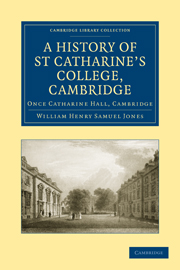Chapter IV - Finance
Published online by Cambridge University Press: 05 June 2011
Summary
Of the pre-Reformation benefactions that do not found Fellowships, those for the Bible Clerk and the Butler have already been noticed in Chapter II, but there remain several others, intended either for the extension or maintenance of the buildings, or in some cases for general purposes. But, like all pre-Reformation endowments, they are bargains rather than gifts; prayers for the dead are as it were bought, and arrangements made to insure as far as possible that the terms of the composition shall be carried out. The donors use the phrase in puram eleemosynam without appearing to realise the discrepancy between their words and their actions.
The grant of a Royal Charter in 1475 enabled St Catharine's to acquire and to sell property, and on 22 November 1475 Woodlark conveyed to the Master and Fellows all the property he had acquired on the Mill Street front, together with all his lands etc. in Cambridge, Grantchester, Barton and Coton, the Manor of Coton and the advowson of the church there, and the reversion of lands and tenements in Over. Nearly two months before the Royal Charter was received, the College seal was (quite illegally) affixed to an agreement with the executors, Henry Hardman and William Twheyts, of William Cotte and Clement Denston. The latter gave 40 towards completing the Chapel and Library, and the Master and Fellows agree to celebrate yearly an obit day with Mass of requiem. “And though we cannot make a fair recompense, yet in part at least we can repay, and so with prayful and joyful minds we make a contribution from our spiritual goods.” This was the second benefaction to the College.
- Type
- Chapter
- Information
- A History of St Catharine’s College, CambridgeOnce Catharine Hall, Cambridge, pp. 205 - 276Publisher: Cambridge University PressPrint publication year: 2010First published in: 1936

